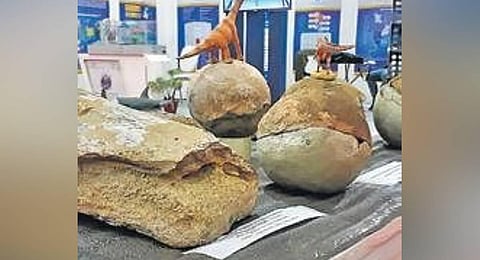

BHOPAL: A rare discovery of 92 closely located dinosaur nests and 256 fossilised eggs of herbivorous Titanosaurs (one of the largest known dinosaurs) has been made by a team of palaeontologists in Dhar district, which is part of the Narmada Valley in Madhya Pradesh.
While dinosaur nests and eggs have been found in the past, too, by other palaeontologists in the Jabalpur region of MP and Balasinor in Gujarat, this recent find raised the possibility of the Narmada Valley having been a fertile hatchery location for dinosaurs millions of years ago.
The field research was carried out by a team of palaeontologists from Delhi University, Indian Institute of Science Education and Research, Mohanpur-Kolkata and Bhopal in many villages of Bagh and Kukshi areas of Dhar district between 2017 and 2020.
A paper on their research by Harsha Dhiman, Vishal Verma, GVR Prasad and others was recently published in the PLOS ONE research journal. “A major inference from the three years of research is that the nests and eggs found in the villages of Dhar district date back 66 million years ago.
"It’s quite possible that the Titanosaurs either just came to lay the eggs in this area of Narmada Valley or the eggs were also hatched there. The eggs found by us show evidence of hatching as well as not having been hatched,” Dhiman, the lead researcher told this newspaper on Saturday.
“Since only nests and eggs and not bones have been found, we need to perform micro CT scan for further research,” Dhiman added.
EGG DIAMETER AROUND 15-17 CM
The nests found in the Narmada valley were close to each other, which is generally not the case. These nests had eggs which ranged between 15 cm and 17 cm in diameter. “Each nest had between one and 20 eggs,” Dhiman said